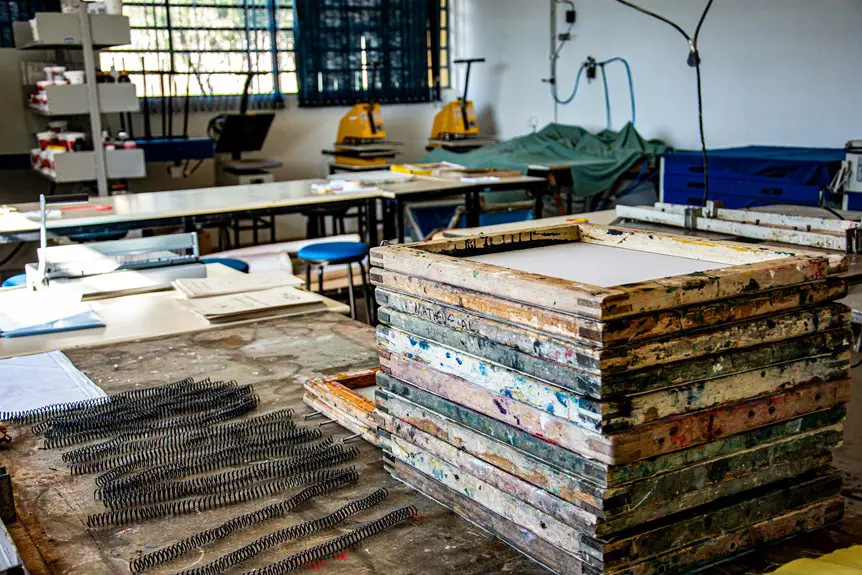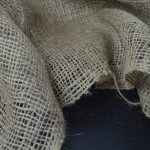To dye acetate fabric, start by selecting disperse or acid dyes, which work best with its heat-sensitive, low-moisture fibers. Thoroughly wash and dry your fabric to remove residues, then dissolve your chosen dye in warm water, avoiding high heat that could damage the fabric. Submerge and stir evenly, rinse until clear, then air-dry away from sunlight. Using the right materials and steps guarantees vibrant, lasting color—keep going to discover detailed tips for perfecting and caring for your dyed acetate.
Table of Contents
Key Takeaways
- Use disperse or acid dyes for vibrant, lasting colors suitable for acetate fabric’s chemical structure.
- Thoroughly wash and air dry fabric before dyeing to remove residues and ensure even dye absorption.
- Dissolve dye completely in warm water; wet fabric evenly before submerging in the dye bath.
- Rinse dyed acetate in cool water until clear, then dry away from direct sunlight to preserve color.
- Handle dyed fabric gently: wash in cold water, avoid wringing, iron on low heat with a pressing cloth.
Understanding Acetate Fabric and Its Dyeing Properties
Acetate fabric, known for its smooth texture and lustrous appearance, presents unique challenges when it comes to dyeing. You’ll find that acetate is a semi-synthetic fiber derived from cellulose, which affects how it absorbs color.
Unlike natural fibers, acetate tends to have low moisture regain, so dyes don’t penetrate as easily. You need to be aware that the fabric is heat-sensitive, meaning high temperatures during dyeing can damage it.
Also, acetate’s chemical structure limits the types of dyes that work effectively. If you’re not careful, the color may not be as vibrant or could wash out quickly.
Understanding these properties helps you handle acetate with the right technique, ensuring better dye uptake and a more durable finish.
Selecting the Right Dye for Acetate
Since the fabric’s chemical makeup limits dye options, you’ll need to choose dyes specifically formulated for acetate. Acid dyes and disperse dyes work best due to their ability to bond with acetate fibers. Avoid fiber-reactive or direct dyes—they won’t produce vibrant, lasting colors. Here’s a quick comparison to help you pick:
| Dye Type | Best For | Pros |
|---|---|---|
| Disperse Dye | Acetate, polyester | Bright, durable colors |
| Acid Dye | Protein fibers, acetate | Good for blends, vibrant |
| Fiber-Reactive | Cotton, linen | Eco-friendly, easy to use |
| Direct Dye | Cellulose fibers | Inexpensive, but fades fast |
Choose disperse or acid dyes to guarantee your acetate fabric has rich, lasting color.
Preparing Your Acetate Fabric for Dyeing
Before you start dyeing, make certain to clean and wash your acetate fabric thoroughly to remove any residues or finishes.
Testing a small fabric swatch first helps you see how the dye will take and behave.
Taking these steps guarantees your final color turns out just right.
Cleaning and Washing
Although you might be enthusiastic to start dyeing, you’ll need to thoroughly clean and wash your fabric first to guarantee the dye adheres evenly. Acetate often has finishes or residues that can block dye absorption. Start by hand washing with a mild detergent and warm water. Avoid harsh chemicals or bleach. Rinse well to remove soap. Let it air dry completely before dyeing.
| Step | Action |
|---|---|
| 1. Inspection | Check for stains or dirt |
| 2. Pre-treat | Use mild detergent |
| 3. Washing | Hand wash gently in warm water |
| 4. Rinsing | Rinse thoroughly with water |
| 5. Drying | Air dry away from direct sun |
Proper cleaning guarantees vibrant, even color results.
Fabric Testing Methods
When you prepare to dye acetate fabric, testing small samples first helps you avoid unexpected results. This step guarantees the dye reacts well with your fabric and meets your color expectations.
Follow these fabric testing methods:
- Color Fastness Test: Apply a small amount of dye on a fabric scrap, then rinse and dry it to check if the color holds without bleeding or fading.
- Absorption Test: Soak the sample in the dye solution briefly to see how well the fabric absorbs the color and if it achieves the desired shade.
- Texture and Finish Check: After dyeing, feel the fabric to confirm the texture and finish remain smooth and undamaged.
Step-by-Step Dyeing Process for Acetate
Dyeing acetate fabric involves several key steps that guarantee vibrant, long-lasting color.
First, prepare your workspace by covering surfaces and gathering gloves, dye, a large pot, and a stirring utensil. Fill the pot with enough warm water to submerge your fabric fully.
Next, dissolve the dye thoroughly in the water, ensuring there are no clumps. Wet your acetate fabric evenly before placing it into the dye bath, which helps the color absorb uniformly.
Keep the fabric moving gently in the bath for 10 to 30 minutes, depending on the desired shade intensity. After dyeing, rinse the fabric in cool water until the water runs clear to remove excess dye.
Finally, gently squeeze out water without wringing and lay flat to dry.
Setting and Fixing the Dye for Durability
Once your acetate fabric has absorbed the dye, you need to set and fix the color to guarantee it lasts. Proper fixing prevents fading and color bleeding, ensuring your fabric stays vibrant over time. Here’s how you do it:
- Rinse in Cold Water: Gently rinse the fabric with cold water to remove excess dye without disturbing the set color.
- Use a Fixative Solution: Soak the fabric in a commercial dye fixative or a vinegar and salt mixture (1 cup vinegar + 1 tablespoon salt in water) for 30 minutes to enhance dye adherence.
- Air Dry Away from Sunlight: Let the fabric dry naturally, avoiding direct sunlight to prevent premature fading.
Following these steps locks in the dye, making your acetate fabric durable and vibrant for the long haul.
Tips for Maintaining and Caring for Dyed Acetate Fabrics
Although acetate fabric offers a beautiful, vibrant finish after dyeing, you’ll want to handle it with care to keep those colors looking fresh.
Always wash your dyed acetate in cold water using a gentle detergent to prevent fading. Avoid wringing or twisting the fabric; instead, gently squeeze out excess water or blot with a towel.
Wash dyed acetate gently in cold water and avoid twisting to keep colors vibrant.
When drying, lay the fabric flat or hang it away from direct sunlight, which can cause colors to fade. Iron on a low heat setting, ideally with a pressing cloth to avoid damage.
Also, store your acetate pieces in a cool, dry place away from prolonged exposure to light.
Frequently Asked Questions
Can Acetate Fabric Be Safely Machine Washed After Dyeing?
You can machine wash acetate fabric after dyeing, but you should use cold water and a gentle cycle to avoid damaging the fibers. Always turn the fabric inside out and avoid harsh detergents to keep colors vibrant.
What Are the Environmental Impacts of Dyes Used on Acetate?
Dyeing can leave a colorful footprint on the environment. You’ll find some dyes release chemicals that affect water and wildlife. Choosing eco-friendly options helps you keep your fabric vibrant without harming our planet’s delicate balance.
How Do I Remove Dye Stains From Non-Acetate Surfaces?
You can remove dye stains from non-acetate surfaces by acting quickly. Blot gently, then use a mixture of mild detergent and water or rubbing alcohol. Test a small area first to avoid damage. Repeat if needed.
Is It Possible to Over-Dye Acetate to Change Colors?
Yes, you can over-dye acetate to change colors, but it may result in a muddier shade. You’ll want to choose a darker dye and test a small area first to avoid unwanted color mixing or damage.
Can I Mix Different Dyes to Create Custom Shades on Acetate?
Like a painter mixing colors on a palette, you can blend different dyes to craft custom shades on acetate. Just test small swatches first, so your unique hues turn out exactly as you want them to.
- The Enduring Appeal of the Guipure Lace Top: A Style Guide - June 25, 2025
- How to Style a Guipure Lace Dress for Any Occasion - June 25, 2025
- Tips for Sewing a Guipure Lace Appliqué Onto Any Garment - June 25, 2025







